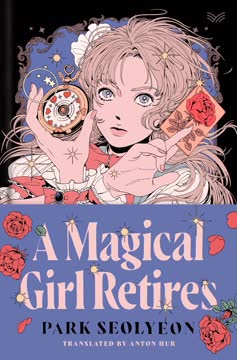Plot Summary
Kiki's Moonlit Departure
On the night of a full moon, thirteen-year-old Kiki, a half-witch, leaves her small town with her black cat Jiji to fulfill the tradition of living independently for a year. Her mother, Kokiri, gives her a sturdy old broom, and her father, Okino, gifts her a red radio. Kiki's only magical skill is flying, and she's determined to use it to find her own way. The bittersweet farewell is filled with hope, nerves, and the promise of self-discovery. As Kiki soars into the night sky, she's buoyed by excitement and the unknown, her heart set on finding a town that needs a witch and a place to call her own.
New Town, New Trials
After a long, exhilarating flight, Kiki and Jiji arrive at the seaside city of Koriko. The bustling town is bigger and busier than Kiki imagined, and her arrival is met with curiosity and suspicion. The townspeople are wary of witches, and Kiki's attempts to introduce herself are met with indifference or fear. Alone and exhausted, Kiki struggles to find a place to stay, her confidence shaken by the city's cold reception. The contrast between her warm hometown and the impersonal city leaves her feeling isolated, but she's determined not to give up.
The First Delivery
Kiki's fortunes change when she meets Osono, a pregnant baker who needs a pacifier delivered to a customer across town. Eager to help, Kiki offers to fly the errand, astonishing Osono and the townspeople. The successful delivery brings relief to a crying baby and gratitude from the mother. For the first time, Kiki feels useful in Koriko, and the experience rekindles her hope. Osono rewards her with bread and, more importantly, offers her a place to stay above the bakery, giving Kiki a foothold in her new life.
Osono's Kindness
Osono's generosity provides Kiki with shelter and encouragement. The bakery becomes a safe haven, and Osono's practical wisdom helps Kiki navigate city life. As Kiki settles into her new room, she reflects on the importance of kindness and community. Osono's acceptance stands in stark contrast to the city's initial coldness, teaching Kiki that one person's support can make all the difference. With renewed determination, Kiki begins to imagine how she might use her flying to help others and carve out a place for herself in Koriko.
Kiki's Delivery Service Opens
Inspired by her first errand, Kiki decides to start a delivery service, using her broom to transport small items for townspeople. Osono helps her set up a tiny storefront, and Kiki names her business "Kiki's Delivery Service." At first, business is slow—people are hesitant to trust a witch. But Kiki's persistence, honesty, and willingness to accept humble payments gradually win over customers. She learns the value of give-and-take, and her confidence grows as she finds purpose in helping others, one delivery at a time.
The Stuffed Cat Catastrophe
Kiki's first major challenge comes when she's hired to deliver a stuffed black cat to a boy for his birthday. During the flight, Jiji accidentally knocks the toy from the broom, and it's lost in a forest. Thinking quickly, Kiki persuades Jiji to pose as the toy until she can retrieve the real one. The plan works, but Kiki must navigate embarrassment, guilt, and the kindness of a local artist who finds the toy. The ordeal tests Kiki's ingenuity and deepens her bond with Jiji, teaching her about trust and improvisation.
Finding Friends and Fitting In
As Kiki continues her deliveries, she meets a variety of townspeople—artists, seamstresses, and other children—each with their own quirks and needs. She befriends Tombo, an aviation-obsessed boy who admires her flying, and Mimi, a girl her own age with secrets of her own. Through these relationships, Kiki learns about vulnerability, jealousy, and the complexities of growing up. She faces moments of loneliness and self-doubt but gradually realizes that being different can be a strength, not a weakness.
Summer Storms and Stolen Brooms
During a summer outing, Kiki's broom is stolen by a boy from Tombo's aviation club, leading to a harrowing rescue and the loss of her mother's cherished broom. Forced to build a new one, Kiki struggles with self-doubt and frustration. The experience humbles her, but with Tombo's help and her own perseverance, she learns to adapt and master her new broom. The ordeal cements her friendship with Tombo and teaches her that setbacks are part of growth.
Tombo and the Art of Flight
Tombo's fascination with flight leads to a partnership with Kiki when she's asked to deliver a large painting. Using Tombo's inventive idea of attaching balloons to the artwork, they successfully transport it across town. The collaboration brings them closer, and Kiki begins to appreciate Tombo's curiosity and kindness. Their friendship, though sometimes awkward, helps Kiki see herself through new eyes and embrace the joy of sharing her unique abilities with others.
Autumn Lessons and Secrets
As autumn arrives, Kiki faces new challenges—delivering secret gifts, handling misunderstandings, and learning to respect others' privacy. She helps a shy girl confess her feelings to a boy, only to accidentally lose the accompanying poem. With Jiji's help, Kiki reconstructs the message, learning about the importance of honesty, humility, and the courage to admit mistakes. These experiences deepen her empathy and understanding of the emotional complexities of adolescence.
Winter's Warmth and Belly Bands
Winter brings a lull in business and a sense of homesickness. Kiki finds warmth in unexpected places—knitting belly bands with an elderly woman, delivering them to sailors, and learning the value of small comforts. The belly bands become a symbol of care and connection, and Kiki's acts of kindness ripple through the community. She realizes that magic isn't just about flying; it's about making life a little brighter for others.
Delivering the New Year
On New Year's Eve, the town's clock tower breaks, threatening to ruin a cherished tradition. The mayor enlists Kiki's help to "borrow" a gear from another town, but Kiki refuses to steal. Instead, she uses her ingenuity and strength to manually move the clock's hands, ensuring the bell rings at midnight. The townspeople celebrate, and Kiki's reputation as a problem-solver and trusted member of the community is solidified. She learns that true magic lies in courage and doing what's right.
Spring's Sound and Song
As spring arrives, Kiki is tasked with retrieving lost musical instruments for a concert. The daring rescue—boarding a moving train and flying back with a string of instruments—turns into an impromptu airborne performance that delights the town. The concert to "beckon spring" becomes a symbol of Kiki's integration into Koriko. She feels a sense of accomplishment and belonging, realizing that her year of challenges has transformed her from an outsider into a cherished part of the community.
A Year's Journey Home
With her year in Koriko complete, Kiki prepares to visit her family. She reflects on her growth, the friendships she's made, and the lessons she's learned. Laden with souvenirs and stories, she flies home, greeted by her parents with pride and affection. The reunion is joyful and affirming, and Kiki shares her experiences, gifts, and newfound confidence. She realizes that both her hometown and Koriko are parts of her identity, and that she now belongs to both.
The Return and Realization
After a brief stay at home, Kiki feels the pull of Koriko and decides to return. She brings gifts for her friends and resumes her life in the city, now fully at ease with herself and her place in the world. Kiki understands that growing up means balancing roots and wings, tradition and individuality. Her journey has taught her resilience, empathy, and the quiet magic of everyday kindness. As she soars over Koriko, Kiki knows she's truly come of age—not just as a witch, but as herself.
Characters
Kiki
Kiki is a thirteen-year-old half-witch, determined to prove herself by living independently for a year. Her only magical skill is flying, which she uses to start a delivery service in the city of Koriko. Kiki is imaginative, impulsive, and sometimes insecure, but her resilience and kindness help her overcome adversity. She struggles with loneliness, self-doubt, and the desire to fit in, but gradually learns to embrace her uniqueness. Through friendships, failures, and small triumphs, Kiki matures into a confident, empathetic young woman who understands that true magic lies in helping others and believing in herself.
Jiji
Jiji is Kiki's black cat companion, raised alongside her as part of witch tradition. He provides comic relief, practical advice, and emotional support, often voicing Kiki's own doubts and fears. Jiji is cautious and sometimes sarcastic, but deeply loyal to Kiki. Their relationship is one of mutual dependence and affection, evolving from playful banter to genuine partnership. Jiji's presence grounds Kiki, and his willingness to help—even when it means posing as a stuffed animal—demonstrates his devotion. As Kiki grows, Jiji's role shifts from caretaker to confidant, reflecting the changing dynamics of adolescence.
Osono
Osono is the pregnant baker who offers Kiki shelter and encouragement when she first arrives in Koriko. She becomes a surrogate mother and mentor, providing practical advice and emotional support. Osono's kindness and acceptance help Kiki find her footing in the city. She models the importance of community, generosity, and resilience, teaching Kiki that small acts of kindness can have a profound impact. Osono's bakery becomes a symbol of warmth and belonging, anchoring Kiki during her most challenging moments.
Tombo
Tombo is a local boy obsessed with flight and aviation. His curiosity about Kiki's flying leads to a sometimes awkward but ultimately meaningful friendship. Tombo admires Kiki's abilities and encourages her to see her magic as something special. He is persistent, supportive, and occasionally clumsy in expressing his feelings. Through their collaboration—especially in solving the painting delivery problem—Tombo and Kiki learn to respect each other's strengths. Tombo represents the excitement and uncertainty of adolescence, as well as the value of teamwork and mutual respect.
Kokiri
Kokiri is Kiki's mother, a witch skilled in herbal medicine and flying. She is both proud and anxious about Kiki's independence, offering guidance while struggling to let go. Kokiri embodies the tension between tradition and change, encouraging Kiki to honor her roots while finding her own path. Her relationship with Kiki is marked by gentle conflict, deep affection, and eventual understanding. Kokiri's wisdom and support remain a touchstone for Kiki throughout her journey.
Okino
Okino is Kiki's human father, a folklorist fascinated by magic and tradition. He provides a calm, rational counterpoint to Kokiri's anxieties, encouraging Kiki to make her own choices. Okino's open-mindedness and quiet humor help ease family tensions. He represents the bridge between the magical and ordinary worlds, supporting Kiki's ambitions while grounding her in family love.
Mimi
Mimi is a girl Kiki's age who hires her to deliver a secret gift to a boy she likes. Initially appearing confident and aloof, Mimi reveals her own insecurities and longing for connection. Her interactions with Kiki highlight the complexities of adolescent friendship, vulnerability, and the desire to be understood. Through their shared confessions, Mimi and Kiki become friends, each learning from the other's strengths and fears.
The Artist
The artist is a woman who befriends Kiki after finding the lost stuffed cat. She is searching for the "blackest black" for her painting and is fascinated by Kiki's witchiness. Her creative spirit and acceptance help Kiki see herself as a source of inspiration. The artist's portrait of Kiki and Jiji becomes a symbol of belonging and self-acceptance, and her support helps Kiki gain recognition in the community.
The Mayor
The young mayor of Koriko is eager to prove himself and maintain the town's traditions. When the clock tower breaks, he enlists Kiki's help, revealing both his vulnerability and his reliance on others. The mayor's interactions with Kiki underscore the importance of trust, responsibility, and the willingness to seek help in times of crisis.
Violet
Violet is a handywoman who hires Kiki for an unusual delivery and teaches her the value of making do and finding joy in small things. Her practical wisdom and upbeat attitude inspire Kiki to appreciate the everyday magic of resilience and adaptability. Violet's approach to life—singing through chores, improvising solutions—mirrors Kiki's own journey toward self-reliance and optimism.
Plot Devices
Coming-of-Age Journey
The central narrative device is the coming-of-age journey, structured around Kiki's year of independence. Each chapter presents a new challenge or lesson, mirroring the emotional and psychological growth of adolescence. The episodic structure allows for a variety of encounters—deliveries, friendships, setbacks—that collectively shape Kiki's identity. The journey is both literal (flying to a new town, returning home) and metaphorical (navigating self-doubt, learning empathy, embracing change).
Everyday Magic and Mundane Tasks
Kiki's only magical skill—flying—forces her to rely on creativity, resourcefulness, and hard work. The plot uses magical realism to highlight the wonder in everyday life, turning simple errands into adventures. The delivery service becomes a vehicle for exploring themes of community, kindness, and the value of small acts. Magic is demystified, shown as an extension of personal effort and intention rather than supernatural power.
Foreshadowing and Symbolism
The bells in the treetops, the old broom, the belly bands, and the clock tower all serve as symbols of transition, connection, and the passage of time. Early warnings about the challenges of city life foreshadow Kiki's struggles. The recurring motif of flying—sometimes smooth, sometimes turbulent—mirrors Kiki's emotional state and development. The act of returning home, only to feel the pull of Koriko, symbolizes the balance between roots and wings.
Community and Reciprocity
The plot is driven by acts of exchange—deliveries, gifts, favors—that build relationships and trust. Kiki's willingness to accept humble payments and help others, even when unappreciated, gradually transforms her from outsider to insider. The narrative structure emphasizes the importance of community, mutual support, and the idea that everyone has something to offer.
Analysis
Kiki's Delivery Service is a luminous exploration of adolescence, independence, and the quiet magic of everyday kindness. Through Kiki's journey, Eiko Kadono crafts a narrative that celebrates resilience, empathy, and the courage to be oneself. The story's episodic structure mirrors the unpredictable rhythms of growing up—each delivery, mishap, and friendship becomes a stepping stone toward self-acceptance. Kiki's struggles with loneliness, self-doubt, and the desire to fit in are universal, yet her willingness to help others transforms both her own life and the community around her. The novel gently subverts the fantasy genre by grounding magic in the mundane, suggesting that true power lies not in spells but in perseverance, creativity, and compassion. In a modern context, Kiki's story resonates as a reminder that everyone possesses a unique "magic"—a talent, a kindness, a spark—that can brighten the world. The lessons of give-and-take, the value of community, and the importance of embracing change are as relevant today as ever, making Kiki's Delivery Service a timeless coming-of-age tale for readers of all ages.
Last updated:
Review Summary
Kiki's Delivery Service is a beloved children's novel about a young witch finding her place in the world. Readers praise its charming characters, heartwarming story, and themes of independence and community. Many appreciate its cozy, magical atmosphere and relatable protagonist. While some find the episodic structure and simple writing style better suited for younger readers, others enjoy its nostalgic appeal. The book differs from the popular Studio Ghibli film adaptation, offering new adventures for fans to discover. Overall, it's considered a delightful, wholesome read for all ages.
魔女の宅急便 [Majo no Takkyūbin] Series
Similar Books
Download PDF
Download EPUB
.epub digital book format is ideal for reading ebooks on phones, tablets, and e-readers.










